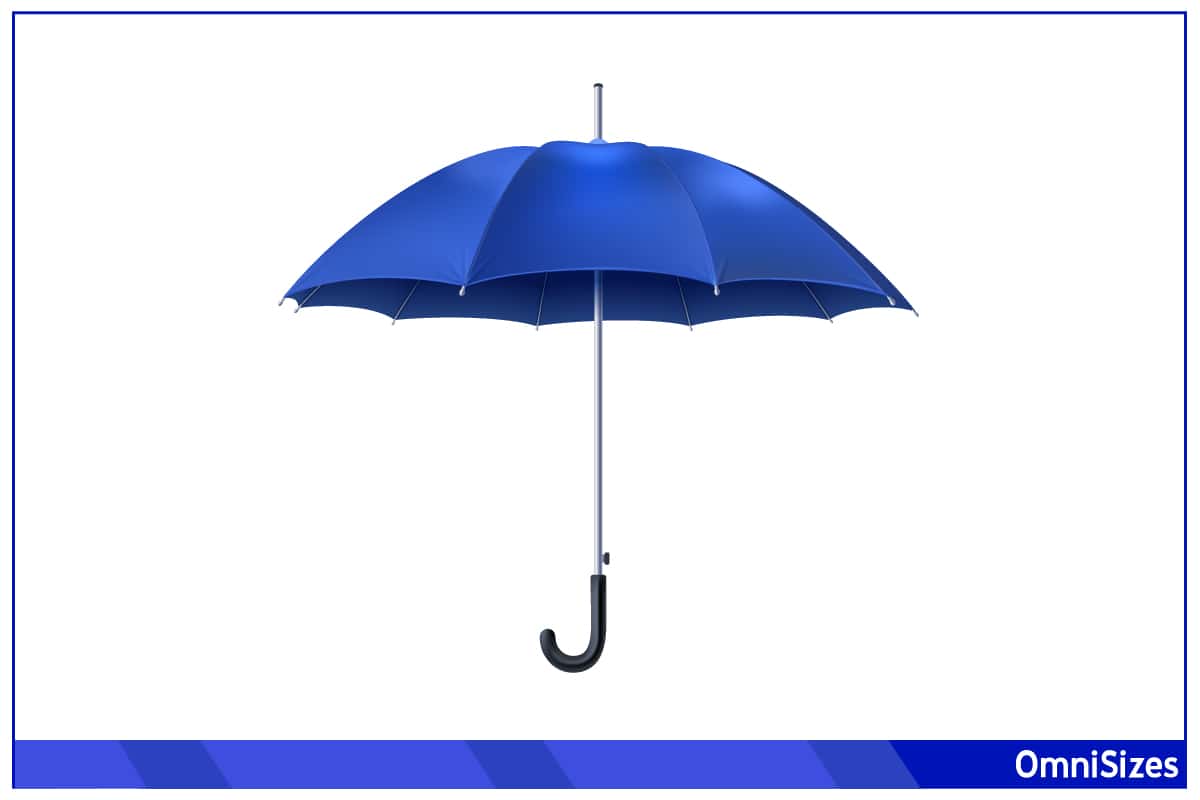When we think of umbrellas, often it’s about protection from rain or sun. However, umbrella sizes can significantly their coverage and convenience. There are tiny, pocket-sized models for single-person usage to large golf umbrellas that can cover a small family.
The size of an umbrella ultimately depends on its type. There are several kinds of umbrellas to choose from, including rain and canopy umbrellas. Here’s a quick breakdown of common size and weight ranges for different umbrella types:
| Umbrella Type | Diameter Range |
| Rain Umbrellas | 2-2/3 to 6 ft. |
| Market Umbrellas | 6 to 15 ft. |
| Patio Umbrella | 6 to 10 ft. |
| Beach Umbrellas | 6 to 7 ft. |
| Golf Umbrellas | 4 to 6 ft. |
This guide will take you deeper into the vast world of umbrellas. It will cover the various types of umbrellas and common sizes, as well as explain how an umbrella is measured.
Umbrella Types and Sizes
The wide world of umbrellas includes more than devices designed to protect you from the rain. Here, we’ll take a glimpse at the various types of umbrellas and their sizes.
1. Rain Umbrellas

Rain umbrellas are your everyday heroes. These are typically made from waterproof materials like nylon and come in a variety of sizes. The most common are compact, easy-to-carry ones that fit in your bag, and the full-size, more sturdy ones that offer better coverage.
What’s cool is the tech in some of these, such as automatic open and close, wind-resistant frames, and even UV protection for those surprise sunny moments.
2. Market Umbrellas

Market umbrellas are the big guys you see in outdoor markets or bustling streetside cafes. They’re usually larger than rain umbrellas, designed to provide shade for a wider area.
They’re not just big but also strong, often made with heavy-duty materials and sturdy poles. The fabrics are usually UV-resistant too, so they protect you from the sun while adding a cozy vibe to outdoor spaces.
3. Patio Umbrellas

Patio umbrellas are the chill cousins of the umbrella family. These are specifically designed for residential outdoor spaces like gardens or poolsides.
They come in various shapes—round, rectangular, or even square—and sizes to fit different types of outdoor furniture. Some of these are even cantilevered, meaning they have an off-center base, which is great for covering large areas without a pole in the middle.
4. Beach Umbrellas

Beach umbrellas are your sunny day essentials. They’re designed to be lightweight and portable, yet strong enough to not fly away with the seaside breeze.
Look for ones with a pointed end to easily anchor into the sand. They usually come with a tilt mechanism for optimal sun protection, and the fabrics are often vibrant, quick-drying, and UV-resistant.
5. Golf Umbrellas

Golf umbrellas are oversized for a reason: to protect you and your golf gear. These umbrellas have a robust build to withstand windy conditions on the golf course. They’re not just for golfers, though—anyone looking for extra coverage will appreciate their size and durability.
Umbrella Size Chart
| Umbrella Type | Canopy Diameter Range | Length Range | Weight Range |
| Rain Umbrellas | 2-2/3 to 6 ft. | 2 to 3 ft. | 2 to 10 lbs. |
| Market Umbrellas | 6 to 15 ft. | 6 to 7 ft. | 75 to 200+ lbs. |
| Patio Umbrellas | 6 to 10 ft. | 6 to 7 ft. | 20 to 100 lbs. |
| Beach Umbrellas | 6 to 7 ft. | 6 to 7-1/2 ft. | 4 to 20 lbs. |
| Golf Umbrellas | 4 to 6 ft. | 2 to 4 ft. | 2 to 15 lbs. |
How to Measure an Umbrella
When it comes to umbrella sizes, most people would think of its length and canopy diameter. However, there’s more to it than meets the eye.
1. Overall Length
This is probably the simplest measurement of an umbrella. The overall length refers to the length from the base of the handle (bottommost part for curved umbrella handles) to the end tip (the pointed top of the umbrella, if available).
2. Shaft Length
The shaft of an umbrella is the metal or wooden rod, which oftentimes includes the handle. This measurement is taken from the base of the handle to bottom of the end tip. To get this measurement, you will need to open the umbrella by pushing the runner up toward the tip.
In a folding or collapsible umbrella, the shaft and handle are separate components. It usually has a telescoping shaft, which reduces the overall length of the umbrella when not in use. Stick umbrellas, on the other hand, retain their length whether it’s in use or not.
3. Canopy Length
The canopy of an umbrella is the silk, acetate, rayon, or nylon portion of the umbrella. It’s the part that actually protects you from the rain and sunrays. Its length is measured from where it’s connected to the tip to end of each rib (the poles that extend outward from the tip and give the umbrella structure) when the canopy is closed.
4. Canopy Height
Canopy height is similar to canopy length in that it measures from the tip of the umbrella to the bottom end of a rib. The main difference is that canopy height is taken when the umbrella is open. In most cases, a higher canopy height makes the umbrella’s canopy appear more sloped.
5. Canopy Diameter and Radius
Diameter refers to the distance between the widest points of the canopy when extended. It determines how many people it can cover from the elements. Generally, the wider the canopy diameter, the more people it covers, and the heavier the umbrella becomes.
You can get the radius of an umbrella simply by halving the canopy’s diameter. The radius can help you understand how much space each person has underneath the canopy.
6. Canopy Arc
Finally, there’s the arc of the canopy. This is the distance of a rib to the opposite rib along the canopy’s top curve. The arc is usually longer than the canopy’s length and diameter. This figure, along with the diameter, will give you a good idea of how many people can fit underneath the canopy.






